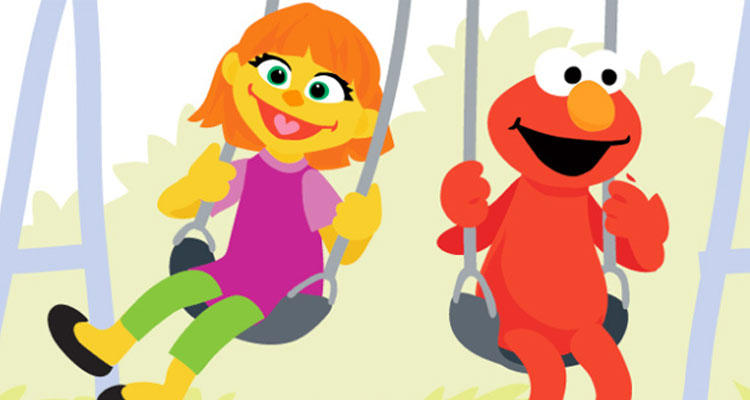Last week, after more than 40 years on Sesame Street, Elmo introduced his long-time friend Julia to other Muppets and audiences around the globe.
Orange-haired and green-eyed with a wide grin, Julia is cute as a button with personality to match.
But Julia, who loves to play on the swings, is sometimes slow to respond. She rarely looks directly at new acquaintances, is easily scared by certain noises, and sometimes flaps her arms expressing excitement. When it comes to playing with Elmo’s toy trucks, she especially likes to watch the wheels spin.
Julia, like 1 in 68 American children (according to the Centers for Disease Control and Prevention) has autism.
Sesame Street introduced Julia as part of its new initiative, “Sesame Street and Autism.” Not yet part of the television broadcast, Julia debuts in the online storybook We’re Amazing, 1, 2, 3! and is a featured character in several videos as well as in a series of “routine cards” designed to teach basic skills to young students with autism.
Those closest to the autism community see Julia and the Sesame Street initiative as positive steps toward enlightening children and their families about those affected by autism and the struggles they can face to fit in.
“Kids on the autism spectrum get bullied five times more often, so it’s really important so children can learn to be accepting and understanding of one another,” Elise Sole, a senior writer for Yahoo! Parenting told ABC News.
Prominent in Sesame Street’s “See Amazing in All Children” social media campaign (#seeamazing) is a YouTube video in which Julia’s new friend, the Muppet Abby, says, “Lots of kids have autism and that just means their brains work a little differently.”
[embedvideo id=”RuV8AddbXIs” website=”youtube”]
The campaign also features The Amazing Song, the chorus of which is “we all are amazing, each in our own way.”
[embedvideo id=”VWrg5b9DQbE” website=”youtube”]
“The Sesame Street campaign is really helping them [kids with autism] see they’re not alone,” says Michael Rosanoff, director of public research at Autism Speaks, one of numerous organizations that have been consulting for more than a year to help refine the Sesame Street effort.
Dr. Michael Robb, director of research for Common Sense Media told National Public Radio that Sesame Street’s focus on autism is “pretty groundbreaking.” Robb says, “It can be difficult to start a conversation about children with disabilities. It’s even harder when that difference isn’t visible.”
Even so, the program’s best efforts have not gone without criticism.
Although the “Sesame Street and Autism: See Amazing in All Children” program is available as an app and on desktop, some say it will only register with those who seek it out. Explaining autism and its social impacts to a wider audience, they maintain, will come only when Sesame Street includes Julia in its TV family.
Sesame Workshop Vice President Jeanette Betancourt said producers will evaluate feedback before going further. “We’re looking to do this in a very thoughtful fashion,” Betancourt told the New York Times. “We want to hear back from the autism community about what other resources would be helpful, whether we should animate her further or offer video content.”
Two other concerns: Why did the producers choose a female character, given that boys are four times more likely to suffer from autism? And will Julia create a snapshot that limits the understanding of autism which can manifest itself in a wide range of traits?
“We don’t pretend that every child who is on the spectrum is the same,” explained Sesame Street Executive Producer Sherrie Weston in an interview with the Los Angeles Times. “We made sure she was a girl namely because autism is seen so much more often in boys. We wanted to make it clear that girls can be on the spectrum, too. We’re trying to eliminate misconceptions.”




































